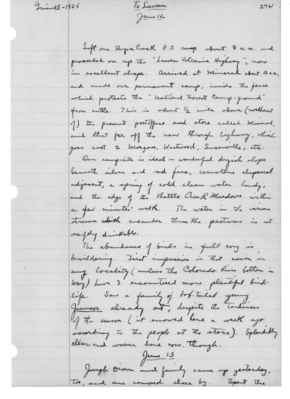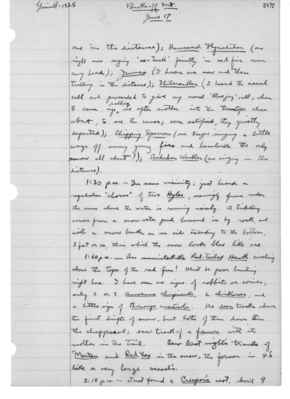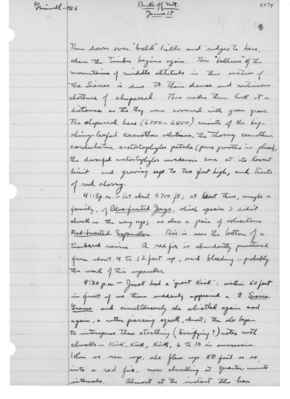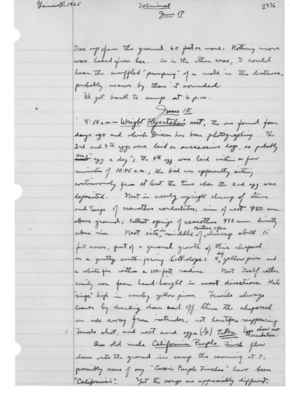Pages That Mention chaparral
1925: Joseph Grinnell's field notes
S2 Page 5
Collector: Grinnell - 1925 Location: Lassen Section Date: June 12-13, 1925 Page Number: 2461
Left our Payne Creek P.O. camp about 8 a.m. and proceeded on up the "Lassen Volcanic Highway", now in excellent shape. Arrived at Mineral about 10 a.m., and made our permanent camp, inside the fence which protects the "National Forest Camp-ground" from cattle. This is about 1/2 mile above (northeast of) the present postoffice and store called Mineral, and that far off the new thorough highway, which goes east to Morgan, Westwood, Susanville, etc. Our campsite is ideal - wonderful dryish slope beneath silver and red firs, ceanothus chaparral adjacent, a spring of cold clean water handy, and the edge of the Battle Creek Meadows within a few minutes' walk. The water in the various streams which meander thru the pastures is not safely drinkable. The abundance of birds in full song is bewildering. First impression is that never in any locality (unless the Colorado River bottom in May) have I encountered more plentiful bird life. Saw a family of bob-tailed young Juncos already out, despite the tardiness of the season (it snowed here a week ago according to the people at the store). Splendidly clean and warm here now, though. June 13, 1925. Joseph Dixon and family came up yesterday, too, and are camped close by. Spent the
S2 Page 17
Collector: Grinnell - 1925 Location: Lassen Section (Brokeoff Mt.) Date: June 17, 1925 Page Number: 2472
one in the distance); Hammond Flycatcher (one right now saying "see-Tuck" faintly in red fir over my head); Junco (I hear one now and then trilling in the distance); Nutcracker (I heard the nasal call and proceeded to give my usual "bluejay" call, when 5 came up, calling, one after another into the treetops close about, to see the cause; soon satisfied, they quietly departed); Chipping Sparrow (one keeps singing a little way off away young firs and hemlocks the only snow all about!); Audubon Warbler (one singing in the distance). 1:30 p.m. - In same vicinity; just heard a regulation "chorus" of two Hylas, seemingly from under the snow where the water is running noisily. A tributary comes from a snow-water pond hemmed in by rock, and with a snow bank on one side extending to the bottom, 3 feet or so, thru which the snow looks blue like ice. 1:50 p.m. - An unmistakable Red-Tailed Hawk circling above the tops of the red firs! Must be poor hunting right here. I have seen no signs of rabbits or conies; only 2 or 3 Amoenus Chipmunk, 2 chickadees, and a little sign of Thomomys monticola. No deer tracks above the first drifts of snow, but lots of them down thru the chaparral; saw track of a fawn with its mother in the trail. Saw last night's tracks of Marten and Red Fox in the snow, the former in 4's like a very large weasel's. 2:15 p.m. - Just found a Creeper's nest, about 9
S2 Page 19
Collector: Grinnell - 1925 Location: Lassen Section (Brokeoff Mt.) Date: June 17, 1925 Page Number: 2474
Then down over "bald" hills and ridges to here, where the Timber begins again. This "baldness" of the mountains of middle altitude in this section of the Sierras is due to their dense and continuous clothure of chaparral. This makes them look at a distance as tho they were covered with green grass. The chaparral here (6000-6500) consists of the big shiny-leafed ceanothus velutinus, the thorny ceanothus condulatus, arctostaphylos patula (pure growths in places), the dwarfed arctostaphylos nevadensis here at its lowest limit and growing up to two feet high, and tracts of red cherry. 4:15 p.m. - At about 6700 ft.; at least there, maybe a family, of Blue-fronted Jays, which species I didn't check on the way up; as also a pair of solicitous Red-breasted Sapsuckers. This is near the bottom of a timbered ravine. A red fir is abundantly punctured from about 4 to 12 feet up, and bleeding - probably the work of this sapsucker. 4:30 p.m. - Just had a "great kick": within 50 feet in front of us there suddenly appeared a female Sierra Grouse and simultaneously she whistled again and again, a rather piercing squall, almost; then she began to intersperse these startling (terrifying?) notes with clucks - kirk, kirk, kirk, 6 to 10 in succession. When we ran up, she flew up 80 feet or so into a red fir, now clucking at quarter-minute intervals. Almost at the instant the hen
S2 Page 21
Collector: Grinnell-1925 Location: Mineral Date: June 17 Page Number: 2476
tree up from the ground 60 feet or more. Nothing more was heard from her. As in the other case, I could hear the muffled "pumping" of a mile in the distance, probably nearer than it sounded.
We got back to camp at 6pm.
8:15 a.m -- Wright Flycatcher's nest, the one found four days ago and which Dixon has been photographing. The 3rd and 4th eggs were laid on successive lays, so probably an "egg a day"; the 4th egg was laid within a few minutes of 10:45 a.m.; the bird was apparently sitting continuously from at least the time when the 2nd egg was deposited. Nest in nearly upright clump of stems and twigs of Ceanothus cordulatus; rim of nest 950 mm. above ground; tallest sprigs of ceanothus 490 mm. directly above rim. Nest site in middle of rather open clump about 15 feet across, part of a general growth of this chaparral on a gently south-facing hill-slope; 4 big yellow pines and a white fir within a 100-foot radius. Nest itself rather easily seen from head-height in most directions. Male "sings" high in nearby yellow pines. Female always leaves by ducking down and off thru the chaparral on side away from intruder, not heretofore reappearing. Female shot, and nest and eggs (1/4) taken. Eggs show no incubation.
One old male California Purple Finch flew down onto the ground in camp this morning at 7; possibly some of my "Cassins Purple Finches" have been "California's". Yet the songs are appreciably different.
S2 Page 52
Collector: Grinnell - 1925 Location: Mineral Date: June 28 Page Number: 2506
per acre. The tract in question is gently sloping toward the south; while there is no water on it, water is within easy reach, at the camp ground spring 100 yards to the east or at the first willow bog 200 yards to the south. The vegetation is mixed conifer and chaparral, the later by area predominating and consisting almost solely of ceanothus cordulatus, so greatly like by many birds because it affords safe nesting places plus (right now) an abundance of insect life. The conifers on it are chiefly firs (white), but there are also lone yellow pines, affording lofty perches, and some incense cedars.
We have seen many other birds on our plot, besides those named on the map - foragers or vagrants from adjacent ground; for example, Calif. Purple Finches, Siskins, and Evening Grosbeaks; and at night, Pacific Nighthawks. One puzzling case is that of Calliope Hummers, of which 4 males have separate distinct "stands" on our plot. The females come onto the plot to forage about the castillejas plentiful in the brush, but as far as we can judge, these females are only visitors, having there [sic] nests off somewhere, probably in the belt of lodge pole pines down along the willow-bogs, where the males do not go. One male has his "stand" one telefone [sic] wire, which crosses our plot near its southern boundary. Beneath




